#cleaning technology
Text
Discover the Latest Innovations in Cleaning Products for Your Home
Certainly! Here’s an example blog post that follows the outline provided:
I. Introduction
When it comes to living a healthy lifestyle, many people focus on the physical aspects – eating well, exercising regularly, and getting enough sleep. But mental health is just as important, if not more so, for overall well-being. In this blog post, we’ll explore some simple ways to prioritize your mental…
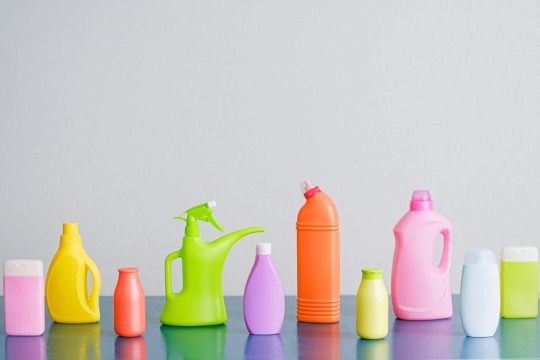
View On WordPress
#all-natural#chemical-free#cleaning products#cleaning technology#durable#fragrance-free#healthy living#here are some recommended tags for discovering the latest innovations in cleaning products for your home:#home appliances#home cleaning#household#hygiene#innovations#multi-purpose#non-toxic#organic#powerful#recyclable#reusable#sanitation#smart cleaning
2 notes
·
View notes
Text
Sanitation Vehicles Market: Navigating the Path to Cleaner Cities
Key Takeaways:
The Sanitation Vehicles Market is witnessing significant growth owing to the increasing focus on cleanliness and waste management in urban areas. Key takeaways from the market indicate a rising demand for sanitation vehicles equipped with advanced technologies to improve efficiency and sustainability. Municipalities and waste management companies are investing in modern sanitation vehicles to enhance waste collection, recycling, and disposal processes. Additionally, the adoption of electric and hybrid sanitation vehicles is on the rise, driven by environmental regulations and the need to reduce carbon emissions. Overall, the market presents lucrative opportunities for manufacturers to innovate and cater to the evolving needs of the sanitation sector.
The Global Sanitation Vehicle Market Size was valued at US$ 15.44 Bn in 2024 and is expected to reach US$ 16.66 Bn by 2031 at a CAGR of 5.4% between 2024 and 2031.
Market Key Trends:
Several key trends are shaping the Sanitation Vehicles Market. One notable trend is the integration of smart technologies and IoT-enabled solutions in sanitation vehicles to optimize operations and improve service delivery. These technologies enable real-time monitoring of vehicle performance, route optimization, and predictive maintenance, resulting in cost savings and enhanced productivity. Another trend is the emphasis on sustainable waste management practices, driving the development of eco-friendly sanitation vehicles powered by alternative fuels such as compressed natural gas (CNG) or hydrogen. Furthermore, there is a growing focus on modular and customizable sanitation vehicle designs to accommodate various waste collection and disposal requirements.
Porter's Analysis:
Conducting a Porter's analysis provides insights into the competitive dynamics and market forces at play in the Sanitation Vehicles Market. The bargaining power of suppliers in the market is moderate, influenced by factors such as the availability of raw materials, technological expertise, and regulatory compliance. The threat of new entrants is relatively low due to high capital requirements, stringent safety and environmental standards, and established relationships with municipal authorities. Buyer power varies depending on factors such as purchase volume, contract terms, and the availability of alternative sanitation solutions. Intense rivalry among existing competitors drives innovation and product differentiation to gain a competitive edge in the market.
Geographical Regions:
Geographical regions play a crucial role in shaping the Sanitation Vehicles Market, with different regions exhibiting varying levels of demand and market dynamics. Developed regions such as North America and Europe are major markets for sanitation vehicles, driven by strict environmental regulations, robust waste management infrastructure, and high urbanization rates. Emerging economies in Asia-Pacific, Latin America, and Africa present significant growth opportunities fueled by rapid urbanization, rising disposable incomes, and government initiatives to improve sanitation infrastructure. Additionally, regions prone to natural disasters or health crises often witness increased demand for sanitation vehicles to support emergency response and disaster recovery efforts, further driving market growth.
Get More Insights On This Topic; Sanitation Vehicles Market
#Sanitation Vehicles Market#Waste Management#Municipal Services#Environmental Solutions#Garbage Collection#Recycling Equipment#Urban Infrastructure#Cleaning Technology#Public Health
0 notes
Text
Bin Bidet: Elevating Hygiene with Premier Bin Cleaning Service
Step into a world of unparalleled cleanliness with Bin Bidet, your ultimate Bin Cleaning Service provider. At Bin Bidet, we're dedicated to transforming the way you think about bin hygiene. Our expertly designed service guarantees not just a clean bin but a complete hygienic overhaul for your waste receptacles. Using cutting-edge technology combined with eco-friendly cleaning solutions, we tackle the dirt, grime, and germs that regular cleaning misses. Say farewell to unpleasant odors and unwelcome pests, and embrace a healthier, fresher living environment. Our commitment to excellence and customer satisfaction means we offer tailored solutions to fit your specific needs, ensuring your bins are impeccably clean and hygienic. Choose Bin Bidet for a cleaner, greener, and more pleasant home or business space. Contact us now and experience the difference of a professional Bin Cleaning Service!
0 notes
Text
Revolutionize Your Cleaning Process with Laser Cleaning Machine
Laser cleaning machine uses the power of laser technology to remove rust, paint, oil, and other contaminants from various surfaces, including metal, plastic, stone, and more. Unlike traditional cleaning methods, the laser cleaning machine doesn't generate any dust or debris, making it a safe and clean alternative. Our laser cleaning machine is easy to use and can be operated by anyone. Simply point the laser at the surface you want to clean, and watch as the machine removes dirt and grime with precision and speed. Plus, our machine is energy-efficient and can be used for extended periods without overheating or causing any damage. For more details contact Laser Cleaner.
#laser cleaning#cleaning technology#industrial cleaning#surface preparation#non-invasive cleaning#eco-friendly cleaning#revolutionary cleaning#automated cleaning#precision cleaning#cleaning equipment#cleaning solutions
0 notes
Text
"A 1-megawatt sand battery that can store up to 100 megawatt hours of thermal energy will be 10 times larger than a prototype already in use.
The new sand battery will eliminate the need for oil-based energy consumption for the entire town of town of Pornainen, Finland.
Sand gets charged with clean electricity and stored for use within a local grid.
Finland is doing sand batteries big. Polar Night Energy already showed off an early commercialized version of a sand battery in Kankaanpää in 2022, but a new sand battery 10 times that size is about to fully rid the town of Pornainen, Finland of its need for oil-based energy.
In cooperation with the local Finnish district heating company Loviisan Lämpö, Polar Night Energy will develop a 1-megawatt sand battery capable of storing up to 100 megawatt hours of thermal energy.
“With the sand battery,” Mikko Paajanen, CEO of Loviisan Lämpö, said in a statement, “we can significantly reduce energy produced by combustion and completely eliminate the use of oil.”
Polar Night Energy introduced the first commercial sand battery in 2022, with local energy utility Vatajankoski. “Its main purpose is to work as a high-power and high-capacity reservoir for excess wind and solar energy,” Markku Ylönen, Polar Nigh Energy’s co-founder and CTO, said in a statement at the time. “The energy is stored as heat, which can be used to heat homes, or to provide hot steam and high temperature process heat to industries that are often fossil-fuel dependent.” ...
Sand—a high-density, low-cost material that the construction industry discards [Note: 6/13/24: Turns out that's not true! See note at the bottom for more info.] —is a solid material that can heat to well above the boiling point of water and can store several times the amount of energy of a water tank. While sand doesn’t store electricity, it stores energy in the form of heat. To mine the heat, cool air blows through pipes, heating up as it passes through the unit. It can then be used to convert water into steam or heat water in an air-to-water heat exchanger. The heat can also be converted back to electricity, albeit with electricity losses, through the use of a turbine.
In Pornainen, Paajanen believes that—just by switching to a sand battery—the town can achieve a nearly 70 percent reduction in emissions from the district heating network and keep about 160 tons of carbon dioxide out of the atmosphere annually. In addition to eliminating the usage of oil, they expect to decrease woodchip combustion by about 60 percent.
The sand battery will arrive ready for use, about 42 feet tall and 49 feet wide. The new project’s thermal storage medium is largely comprised of soapstone, a byproduct of Tulikivi’s production of heat-retaining fireplaces. It should take about 13 months to get the new project online, but once it’s up and running, the Pornainen battery will provide thermal energy storage capacity capable of meeting almost one month of summer heat demand and one week of winter heat demand without recharging.
“We want to enable the growth of renewable energy,” Paajanen said. “The sand battery is designed to participate in all Fingrid’s reserve and balancing power markets. It helps to keep the electricity grid balanced as the share of wind and solar energy in the grid increases.”"
-via Popular Mechanics, March 13, 2024
--
Note: I've been keeping an eye on sand batteries for a while, and this is really exciting to see. We need alternatives to lithium batteries ASAP, due to the grave human rights abuses and environmental damage caused by lithium mining, and sand batteries look like a really good solution for grid-scale energy storage.
--
Note 6/13/24: Unfortunately, turns out there are substantial issues with sand batteries as well, due to sand scarcity. More details from a lovely asker here, sources on sand scarcity being a thing at the links: x, x, x, x, x
#sand#sand battery#lithium#lithium battery#batteries#technology news#renewable energy#clean energy#fossil fuels#renewables#finland#good news#hope#climate hope
1K notes
·
View notes
Text
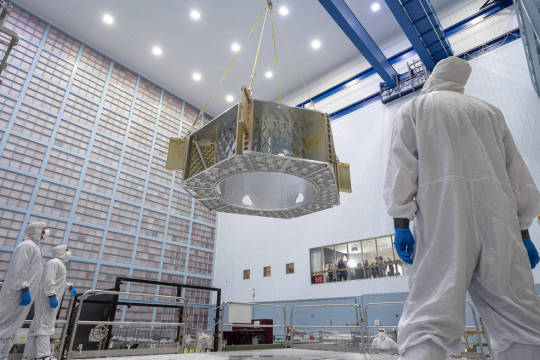
Roman's primary structure hangs from cables as it moves into the big clean room at NASA's Goddard Space Flight Center.
What Makes the Clean Room So Clean?
When you picture NASA’s most important creations, you probably think of a satellite, telescope, or maybe a rover. But what about the room they’re made in? Believe it or not, the room itself where these instruments are put together—a clean room—is pretty special.
A clean room is a space that protects technology from contamination. This is especially important when sending very sensitive items into space that even small particles could interfere with.
There are two main categories of contamination that we have to keep away from our instruments. The first is particulate contamination, like dust. The second is molecular contamination, which is more like oil or grease. Both types affect a telescope’s image quality, as well as the time it takes to capture imagery. Having too many particles on our instruments is like looking through a dirty window. A clean room makes for clean science!
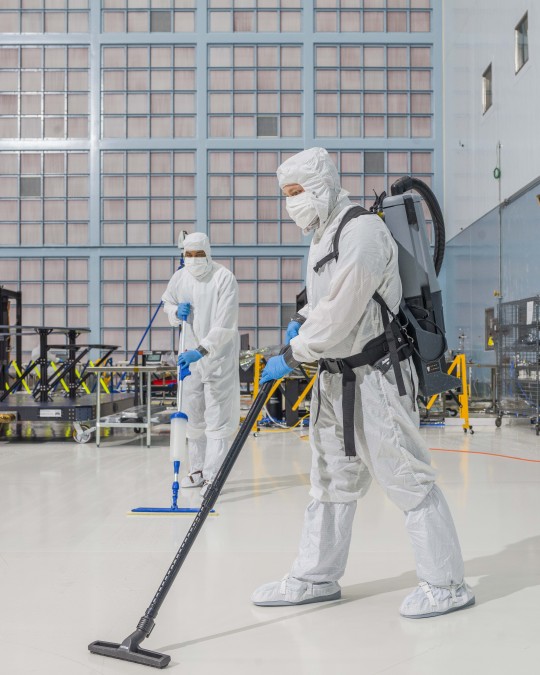
Two technicians clean the floor of Goddard’s big clean room.
Our Goddard Space Flight Center in Greenbelt, Maryland has the largest clean room of its kind in the world. It’s as tall as an eight-story building and as wide as two basketball courts.
Goddard’s clean room has fewer than 3,000 micron-size particles per cubic meter of air. If you lined up all those tiny particles, they’d be no longer than a sesame seed. If those particles were the size of 16-inch (0.4-meter) inflatable beach balls, we’d find only 3,000 spread throughout the whole body of Mount Everest!
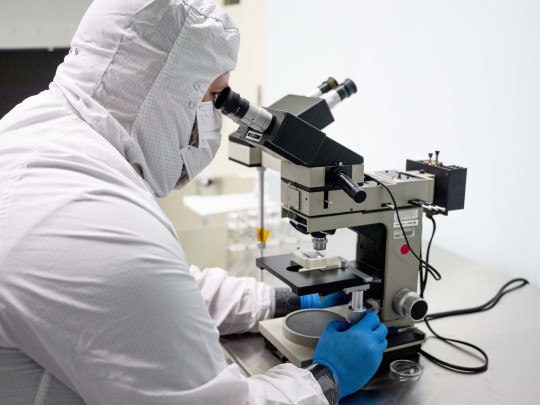
A clean room technician observes a sample under a microscope.
The clean room keeps out particles larger than five microns across, just seven percent of the width of an average human hair. It does this via special filters that remove around 99.97% of particles 0.3 microns and larger from incoming air. Six fans the size of school buses spin to keep air flowing and pressurize the room. Since the pressure inside is higher, the clean air keeps unclean air out when doors open.
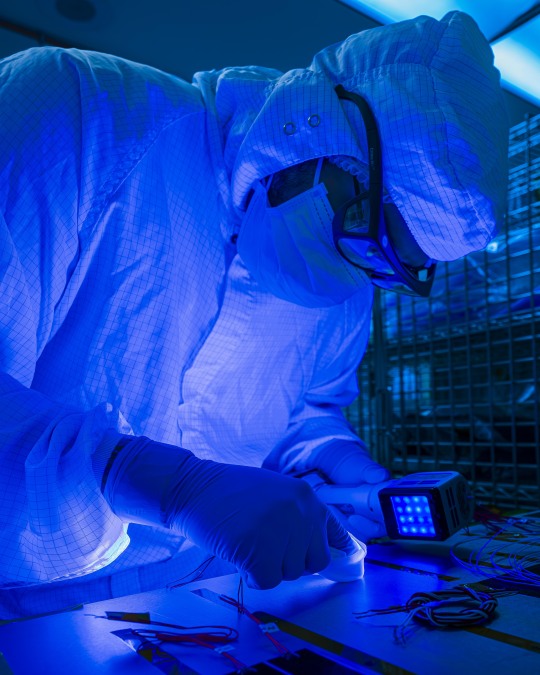
A technician analyzes a sample under ultraviolet light.
In addition, anyone who enters must wear a “bunny suit” to keep their body particles away from the machinery. A bunny suit covers most of the person inside. Sometimes scientists have trouble recognizing each other while in the suits, but they do get to know each other’s mannerisms very well.

This illustration depicts the anatomy of a bunny suit, which covers clean room technicians from head to toe to protect sensitive technology.
The bunny suit is only the beginning: before putting it on, team members undergo a preparation routine involving a hairnet and an air shower. Fun fact – you’re not allowed to wear products like perfume, lotion, or deodorant. Even odors can transfer easily!
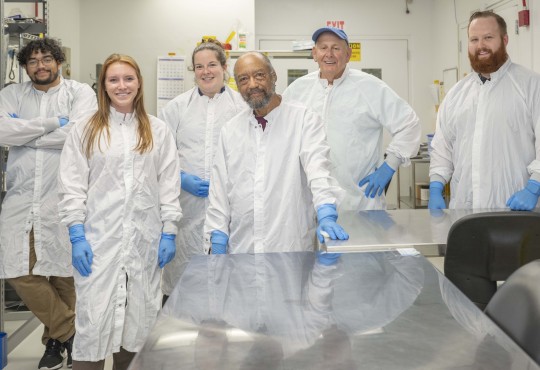
Six of Goddard’s clean room technicians (left to right: Daniel DaCosta, Jill Bender, Anne Martino, Leon Bailey, Frank D’Annunzio, and Josh Thomas).
It takes a lot of specialists to run Goddard’s clean room. There are 10 people on the Contamination Control Technician Team, 30 people on the Clean Room Engineering Team to cover all Goddard missions, and another 10 people on the Facilities Team to monitor the clean room itself. They check on its temperature, humidity, and particle counts.

A technician rinses critical hardware with isopropyl alcohol and separates the particulate and isopropyl alcohol to leave the particles on a membrane for microscopic analysis.
Besides the standard mopping and vacuuming, the team uses tools such as isopropyl alcohol, acetone, wipes, swabs, white light, and ultraviolet light. Plus, they have a particle monitor that uses a laser to measure air particle count and size.
The team keeping the clean room spotless plays an integral role in the success of NASA’s missions. So, the next time you have to clean your bedroom, consider yourself lucky that the stakes aren’t so high!
Make sure to follow us on Tumblr for your regular dose of space!
2K notes
·
View notes
Text



SUPERNATURAL
14.13 Lebanon
#old men arguing in the street confused by technology😔#spnedit#samdeanedit#sam winchester#dean winchester#supernatural#you and me#14x13#draft cleaning#**
435 notes
·
View notes
Text
I really hope they can work the bugs out of this solution, because if it's done right, it'll really be a win-win situation. Less evaporation of water, and solar power being generated every day? Yes, please. We are smart, resourceful beings, and this is far from the most difficult problem we've had to address.
This is also a great example of how we can go back and fix mistakes of the past. We very, very rarely ever come up with technological solutions that take long-term effects on the environment into consideration, and so the way many things are designed often leads to some sort of damage, whether through manufacture, use, disposal, or all of the above. Retrofitting canals (which have been used in agriculture for thousands of years) will have benefits not only in the ways mentioned above, but also gets people thinking more about the impacts we make.
I'm hoping that this will lead to more new technology being developed in ways that already anticipate and account for negative impacts so that they avoid them in the first place, rather than having to engineer new solution many years down the line.
#solar power#solar panels#renewable energy#water#environment#irrigation#agriculture#green energy#conservation#technology#clean energy#science#solarpunk#hopepunk
693 notes
·
View notes
Text
FinFin has been thinking thoughts [Audio recommended]
#you love finfin 🔪#he is your best friend#come and see him#Adore him fr. what a little guy#but also he gives me feelings about the past and the future and everything that's going on in between#and the relationship that people have with art and technology and their ideas for the future#and why they make things and for who#like yes. ok. finfin was just capitalizing on a trend#but even in doing that they made something really unique and charming with lasting appeal#he's more than just a marketable product... and he was even then#he was a genuine curiosity for the tech featured in the game#it doesn't actually work the way it pretends to 😂 but still. The effort was there#fin fin#finfin#fin fin on teo the magic planet#windows 98#windows xp#microsoft agent#I should have spent longer cleaning this up. It's still pretty rough#but it's one of those things you can tweak forever and never be happy with so :/
4K notes
·
View notes
Text
Vast arrays of solar panels floating on calm seas near the Equator could provide effectively unlimited solar energy to densely populated countries in Southeast Asia and West Africa.
Our new research shows offshore solar in Indonesia alone could generate about 35,000 terawatt-hours (TWh) of solar energy a year, which is similar to current global electricity production (30,000TWh per year).
And while most of the world's oceans experience storms, some regions at the Equator are relatively still and peaceful. So relatively inexpensive engineering structures could suffice to protect offshore floating solar panels.
Our high-resolution global heat maps show the Indonesian archipelago and equatorial West Africa near Nigeria have the greatest potential for offshore floating solar arrays.

Continue Reading
289 notes
·
View notes
Text
#good news#environmentalism#science#solar energy#clean water#water desalination#salt water#environment#nature#innovation#green technology
36 notes
·
View notes
Text
Experience the Future of Cleanliness with Bin Bidet's Waste Bin Cleaning Service
Discover a new level of hygiene and convenience with Bin Bidet, the leading Waste Bin Cleaning Service. At Bin Bidet, we understand the importance of maintaining a clean and healthy environment. Our state-of-the-art cleaning technology and eco-friendly methods provide your waste bins with the most thorough cleaning and sanitization they've ever had. Say goodbye to unpleasant odors, bacteria, and pests, and hello to a fresher, cleaner home. Our service is designed to be efficient, affordable, and environmentally responsible, ensuring that your bins are not just clean but also cared for in the most sustainable way possible. With flexible scheduling and customizable plans, Bin Bidet caters to all your waste bin cleaning needs with ease. Join our growing family of satisfied customers and step into a cleaner, healthier future. Contact Bin Bidet today and experience the best in waste bin cleaning!
0 notes
Text
Why Laser Cleaning Machines are the Future of Industrial Cleaning
Laser cleaning machines are the future of industrial cleaning, and for good reason. Traditional cleaning methods such as chemical solvents, sandblasting, and manual scrubbing are time-consuming, hazardous, and can damage the surfaces being cleaned. Laser cleaning machines, on the other hand, provide a safe, efficient, and eco-friendly solution that can tackle even the toughest cleaning jobs. At lasercleaner.com, we offer Handheld Laser Cleaner that use the power of laser technology to remove rust, paint, oil, grease, and other contaminants from a variety of surfaces including metal, concrete, and even delicate materials such as glass and ceramics. Our machines are capable of achieving high levels of precision, ensuring that only the target material is removed without damaging the underlying surface.
#laser cleaning machines#industrial cleaning#cleaning technology#future of cleaning#laser technology#non-contact cleaning#precision cleaning#environmentally friendly cleaning
0 notes
Text
"When a severe water shortage hit the Indian city of Kozhikode in the state of Kerala, a group of engineers turned to science fiction to keep the taps running.
Like everyone else in the city, engineering student Swapnil Shrivastav received a ration of two buckets of water a day collected from India’s arsenal of small water towers.
It was a ‘watershed’ moment for Shrivastav, who according to the BBC had won a student competition four years earlier on the subject of tackling water scarcity, and armed with a hypothetical template from the original Star Wars films, Shrivastav and two partners set to work harvesting water from the humid air.
“One element of inspiration was from Star Wars where there’s an air-to-water device. I thought why don’t we give it a try? It was more of a curiosity project,” he told the BBC.
According to ‘Wookiepedia’ a ‘moisture vaporator’ is a device used on moisture farms to capture water from a dry planet’s atmosphere, like Tatooine, where protagonist Luke Skywalker grew up.
This fictional device functions according to Star Wars lore by coaxing moisture from the air by means of refrigerated condensers, which generate low-energy ionization fields. Captured water is then pumped or gravity-directed into a storage cistern that adjusts its pH levels. Vaporators are capable of collecting 1.5 liters of water per day.

Pictured: Moisture vaporators on the largely abandoned Star Wars film set of Mos Espa, in Tunisia
If science fiction authors could come up with the particulars of such a device, Shrivastav must have felt his had a good chance of succeeding. He and colleagues Govinda Balaji and Venkatesh Raja founded Uravu Labs, a Bangalore-based startup in 2019.
Their initial offering is a machine that converts air to water using a liquid desiccant. Absorbing moisture from the air, sunlight or renewable energy heats the desiccant to around 100°F which releases the captured moisture into a chamber where it’s condensed into drinking water.
The whole process takes 12 hours but can produce a staggering 2,000 liters, or about 500 gallons of drinking-quality water per day. [Note: that IS staggering! That's huge!!] Uravu has since had to adjust course due to the cost of manufacturing and running the machines—it’s just too high for civic use with current materials technology.
“We had to shift to commercial consumption applications as they were ready to pay us and it’s a sustainability driver for them,” Shrivastav explained. This pivot has so far been enough to keep the start-up afloat, and they produce water for 40 different hospitality clients.
Looking ahead, Shrivastav, Raja, and Balaji are planning to investigate whether the desiccant can be made more efficient; can it work at a lower temperature to reduce running costs, or is there another material altogether that might prove more cost-effective?
They’re also looking at running their device attached to data centers in a pilot project that would see them utilize the waste heat coming off the centers to heat the desiccant."
-via Good News Network, May 30, 2024
#water#india#kerala#Kozhikode#science and technology#clean water#water access#drinking water#drought#climate change#climate crisis#climate action#climate adaptation#green tech#sustainability#water shortage#good news#hope#star wars#tatooine
903 notes
·
View notes
Text









#lee taeyong#taeyong#nct icons#taeyong nct#nct u#nct dream#nct 127#nct 2023#taeyong icons#taeyong moodboard#taeyong nct icons#nct#neo zone#neo culture technology#neocities#nctzen#icons moodboard#messy packs#clean moodboard#alternative icons#alternative moodboard#icons soft#alternative aesthetic#clean icons#moodboard coquette#grunge moodboard#green moodboard#y2k moodboard#moodboard#wayv moodboard
110 notes
·
View notes
Text
dr. party (sparklecare hospital) stimboard (with dreamcore and smiley face stims) for @parfettuni !!









smiley bath bomb / minesweeper / playground
pendulum ride / 😊🌈 / gravitron
liminal space / distorted toys / smiley candies
#gin stim#stimboard#stim gif#sparklecare hospital#sparklecare#dr. party#rainbow stim#yellow stim#green stim#blue stim#pink stim#clean stim#technology stim#carnival stim#toy stim#candy stim#cw liminal space#tw liminal space#cw unreality#tw unreality#cw eyestrain#tw eyestrain#cw derealization#tw derealization
23 notes
·
View notes